
10 Powerful and Productive Back-to-School Activities for Your Spanish Class
The first day of Spanish class activities is key. It sets the tone for the rest of the year. This is your moment to inspire your students to fall in love with Spanish at first sight.
Read this article to discover how to channel your students’ excitement. Learn to ramp up their enthusiasm for Spanish during the first day of Spanish class activities!
Helpful Tips for First Day of Spanish Class Activities
When planning your back to school in Spanish activities, aim to make your lessons fun and productive.
First, use as much target language as possible. It is possible to speak Spanish only from Day 1, and the sooner your students get used to it, the better.
Make a list of easy cognates for the beginning Spanish learner. and prepare your lesson plans with them in mind.
Speak more slowly than normal. Don’t be afraid to exaggerate.
Empathize with your students. Recognize how challenging (and amazing) it is to learn a new language.
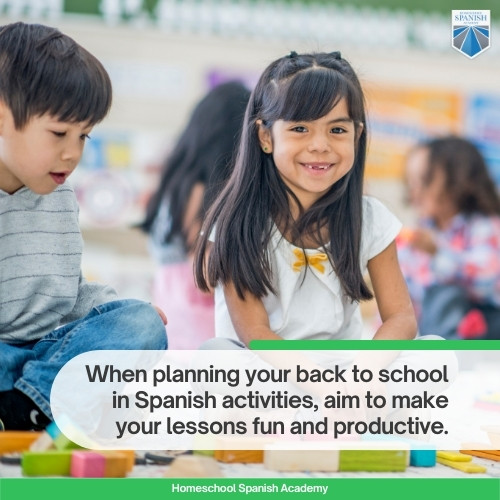
Back to School in Spanish Activities
I prepared a list of icebreakers for your first day of Spanish class with elementary or high school students. Note that many activities for one age group will work with another with minor modifications.
These activities have two goals:
- to help your students feel relaxed and excited about learning Spanish
- to teach them basic Spanish vocabulary and grammar structures
Back to School in Spanish for Elementary Students
Elementary students tend to get excited about everything. This is both wonderful and challenging for teachers.
Your role is to channel their enthusiasm into something productive. Channel their energy to make them work on their Spanish from Day 1.
1. Talking Cards (Tarjetas que hablan)
Materials: Cardboard or paper and crayons or markers
Elementary students love to draw! Distribute blank cards/paper to the students. Ask them to write their names in the center of the card and then draw three things they love.
Ask them to label their drawings in English first. Model your card. I usually draw a person running, a book, and my family.
Then ask them to look up how to say these words in Spanish. Use English-Spanish dictionaries in your classroom or have students search online. They should write the words on the back of their cards.
They present their cards to their friends, saying the words in English and Spanish. Teach them correct pronunciation.
Finally, you can make exit tickets with your students. They need to choose three people and write one thing each of them likes—in Spanish, of course.
Online version: Students have no problems with drawing online. After they’re done, they have to share their screen and present their work.
2. I like/I don’t like (Me gusta/No me gusta) with Cognates
Materials: cognate list on the board, pens, paper
Make a list on the board of things that your students could like or not and make sure it includes cognates only. For example:
- los chocolates – chocolates
- los animales – animals
- las bananas – bananas
- los hospitales – hospitals
- los hoteles – hotels
- los insectos – insects
First, read through the list together. Then say Me gustan…. And choose whatever word you want. Ask the students to raise their hand if they share your feeling.

Then say No me gustan… and also choose a word. Students raise their hands again.
Ask students to divide their card into two columns and write Me gustan on one side and No me gustan on the other. If you have time, they can also make drawings or you can leave this part for homework.
If you consider your students ready, teach them the distinction between me gusta + singular noun and me gustan + plural nouns.
Online version: Use a virtual whiteboard to present the words, and let your students use a drawing program of their choice. They could even do it in a Google Doc.
3. Ball Name Game (Juego de Nombres con Pelota)
Materials: a ball
Sit your students in a circle. Take a ball. Say Me llamo… (My name is…) and your name and throw it to a student.
Ask:
¿Cómo te llamas?
What’s your name?
The student needs to say Me llamo… and his or her name. Then they throw it to another student and ask ¿Cómo te llamas? The game goes on until all students have said their names.
At the end, repeat all the names, pointing to the students and saying:
Ella/Él se llama…
Her/his name is….
This is only an in-class activity; it has no online version.
4. What’s in My Pencil Case? (¿Qué Tengo en mi Estuche?)
Materials: a pencil case with typical school supplies
Show your students a pencil case, point to it, and say “estuche.” Ask them to repeat. Ask:
¿Qué tengo en mi estuche?
What do I have in my pencil case?
Pull items out and say their names with an indefinite article: un lápiz (a pencil), un borrador (an eraser), etc. (See this list of school supplies in Spanish.)
Write all the words you say on the board. Also, write down the phrases
¿Qué tienes en tu estuche?
What do you have in your pencil case?
Tengo…
I have…
Then choose a student and ask ¿Qué tienes en tu estuche? They have to take out all the things and name them saying Tengo un… / una… After they’re done they have to ask somebody from the class ¿Qué tienes en tu estuche? and the game continues.
Online version: The game can be done online with the students’ cameras on and a virtual whiteboard to write down the words and phrases.
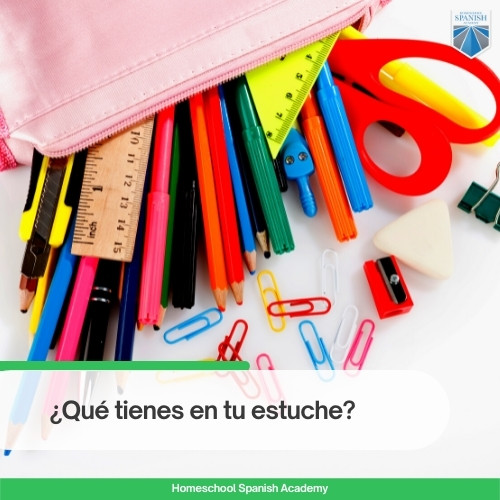
5. Number Game in a Circle (Juego de Números en Círculo)
Materials: Cards with numbers
Have the students stand in a circle. Point to each of them, counting in Spanish: uno, dos, tres… (One, two, three) while you’re handing them cards with their number. Then ask each student to repeat their number aloud.
Then, say one number and all the students need to run to the person with the number. Repeat multiple times. At the end, ask the students to chant all the numbers after you.
This is only an in-class activity; it has no online version.
Back to School in Spanish for High School Students
High school students are teenagers, so they’re a bit more difficult to motivate. How do you get students into the groove and excited to learn Spanish on Day 1? Try one of the following first day of Spanish class activities for high school students.
1. I like / I don’t like (Me gusta/No me gusta) – Tarjetas
Materials: Prepared word cards
This fun activity helps the students get to know each other and practice the me gusta, no me gusta (I like / I don’t like) structure.
Prepare a set of cards with the names of popular actors, singers, video games, etc, and set them in pairs. For example Fifa – Just Dance. Add photos or drawings to embellish them.
Model the activity by pulling out one card and saying: Me gusta Fifa. No me gusta Just Dance. (I like Fifa. I don’t like Just Dance). Write it on the board.
Ask each student to pull the card and choose what they like and what they don’t.
Online version: Use wheelofnames.com and write the pairs there. You spin the wheel for each student.
2. I have, I don’t want, I don’t have, I want (Tengo, no quiero, no tengo, quiero)
Materials: chocolate bars or other small snacks
This activity practices two popular irregular verbs in the first person singular.
Give one snack to each student. Model the activity. For example, hold a Snickers and say:
Tengo un Snickers. No quiero un Snickers. No tengo un Mars. Quiero un Mars.
I have a Snickers. I don’t want Snickers. I don’t have a Mars Bar. I want a Mars Bar.
Then, go to a student that has a Mars Bar, take his Mars Bar and leave him your Snickers. This student needs to do the same as you.
This only works as an in-class activity.
3. Who Is It? Hello. I’m… (¿Quién es…? Hola, Soy…)
Materials: Printed lists with students names for each student
This activity helps the students get to know each other and practice basic expressions. Give a list of students to each of your students. Write on the board:
¿Quién es?
Who is it?
Hola, soy…
Hi, my name is…
Take your own list and say: ¿Quién es John Smith?. When a student raises their hand, point to the board and have the student say Hola soy John. Then point to the student name list and to the board and prompt him to say ¿Quién es…?
Online version: Send lists to the students and do the game with their cameras on.
4. I am, I have, I like (Soy, tengo, me gusta)
Materials: Cardboard or paper and crayons or markers
This is a simple introductory activity for back to school in Spanish.
Make a model card with a name and three phrases. For example:
Sue
Soy Sue.
I’m Sue.
Tengo quince años.
I’m fifteen years old.
Me gusta Britney Spears.
I like Britney Spears.
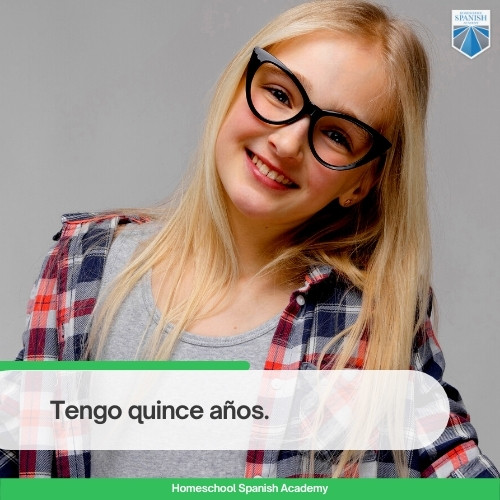
Ask the students to make a similar card for themselves. To make this game more complicated, add country of origin if you’re teaching Spanish in an international environment and the phrase:
Soy de….
I’m from…
Add categories for me gusta, such as actors, video games, books, and movies
Online version: This activity is easily to do online if your students share their screens.
5. Back to School in Spanish Kahoot
Materials: iPads or telephones with Internet access and the following articles:
- Spanish-Speaking Countries in South America
- The Ultimate Guide to Currency in Spanish-speaking Countries
- The One and Only Spanish Speaking Country in Africa
- How Many People Speak Spanish in the World?
- Beyond Bananas: Amazing Exports from Spanish-Speaking Countries
- A Brief, Intriguing History of the Spanish Royal Family
High school students love Kahoots. I use them often to introduce or review topics. I ask my students to create them. It’s easy to create a Kahoot to boost your students’ interest in Spanish and Spanish culture.
Check out this slide with a question based on the last article on the material list I gave you.
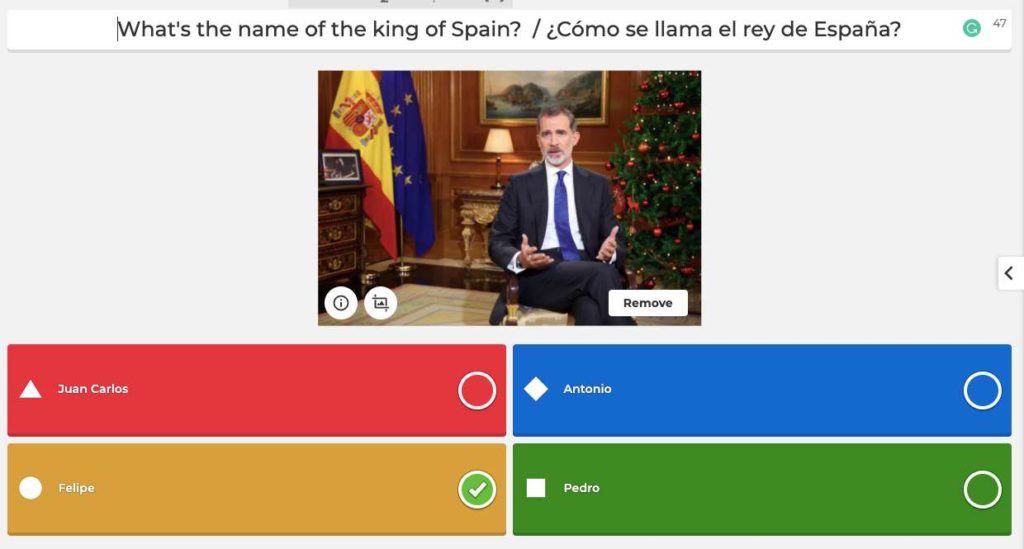
Students can answer individually or in groups. You could give them a time limit or ask them to search for answers online.
Ready to Go Back to School in Spanish?
Start your new academic year strong with a fun and productive first day of Spanish class activities. Empower your students from the first minute and build a strong Spanish foundation. Remember, If they take AP Spanish classes in the future, your teaching can make a difference.
Do you need support in your classroom? Homeschool Spanish Academy provides 1-on-1 or 2-on-1 online Spanish classes for K-12 students. We can help alleviate the difficulty of having many students of varying levels of performance. Sign up for a free class to give us a try today!
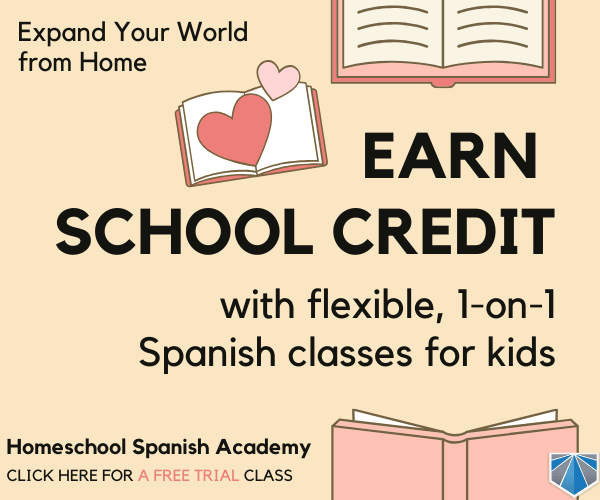
Want more free Spanish lessons, fun content, and easy learning strategies? Check these out!
- Language Learning with Netflix: How to Use the Chrome Extension
- Turn Your Life Around: From Passive Bilingualism to Fluency!
- The Beauty of Spanish Sign Language
- Multilingual Mastery: How Many Languages Can You Learn?
- The Journey of Becoming Trilingual
- Saying It Like a Native: Exploring Spanish Idioms
- Adapting Education: Spanish Lessons for All Learning Styles
- Speak Up! Enhance Your Conversational Spanish
- 10 Homeschooling Styles You Need to Explore in 2023 - March 14, 2024
- Home Sweet Classroom: Creating Engaging Spanish Lessons at Home - October 13, 2023
- Expressing Appreciation in Spanish on World Teachers’ Day - October 5, 2023




